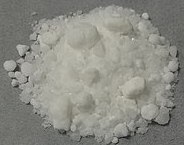Lutetium(III) acetate
This article needs attention from an expert in Chemicals. Please add a reason or a talk parameter to this template to explain the issue with the article. (April 2023) |
 Some white lutetium acetate powder.
| |
| Names | |
|---|---|
| IUPAC names
Tetra-μ2-acetatodiaquadilutetium(III)
lutetium(3+);triacetate neodymium(3+) triacetate | |
Other names
| |
| Identifiers | |
3D model (JSmol)
|
|
| ECHA InfoCard | 100.038.681 |
| EC Number |
|
PubChem CID
|
|
CompTox Dashboard (EPA)
|
|
| |
| |
| Properties | |
| Lu(C2H3O2)3 | |
| Hazards | |
| GHS labelling: | |

| |
| Warning | |
| H315, H318, H335 | |
| P261, P264, P264+P265, P271, P280, P302+P352, P304+P340, P305+P351+P338, P319, P321, P337+P317, P362+P364, P403+P233, P405, P501 | |
| Related compounds | |
Other anions
|
Lutetium(III) oxide Lutetium(III) hydroxide Lutetium(III) carbonate |
Other cations
|
Ytterbium(III) acetate Thulium(III) acetate |
Except where otherwise noted, data are given for materials in their standard state (at 25 °C [77 °F], 100 kPa).
| |
Lutetium(III) acetate is the acetate salt of lutetium with the chemical formula of Lu(CH3COO)3.
Preparation
Lutetium(III) acetate can be prepared through neutralisation, where a lutetium salt reacts with acetic acid to produce lutetium acetate and water:
- Lu2O3 + 6 CH3COOH → 2 Lu(CH3COO)3 + 3 H2O
- Lu(OH)3 + 3 CH3COOH → Lu(CH3COO)3 + 3 H2O
Lutetium(III) acetate also can be obtained by reacting lutetium oxide with gaseous acetic acid[1] or 50% acetic acid solution.[2]
Properties
Lutetium(III) acetate is a water-soluble salt that forms colorless crystals. It forms crystalline hydrates in the form of Lu(CH3COO)3•nH2O, where n = 1 or 4.[citation needed]
Lutetium(III) acetate reacts with ammonium fluoride to produce lutetium fluoride:
- Lu(CH3COO)3 + 3 NH4F → LuF3 + 3 CH3COONH4
The F− formed by the hydrolysis of fluoroborates (such as [BMIM]BF4)[3] can also precipitate with Lu3+.[4]
Reaction with phosphoric acid to produce lutetium phosphate:[5]
- Lu(CH3COO)3 + H3PO4 → LuPO4 + 3 CH3COOH
References
- ^ Janina Wysocka-Lisek. Study of topochemical preparation of rare earth acetates(in Polish). Biuletyn Lubelskiego Towarzystwa Naukowego, Matematyka-Fizyka-Chemia, 1981. 23 (2): 145-149.
- ^ Grählert, Xina; Starke, Graehlert (1992). "Preparation, thermogravimetric study and infrared spectra of rare earth acetates". Preparation, Thermogravimetric Study and Infrared Spectra of Rare Earth Acetates. 34 (2): 219–229.
- ^ Note: The original text is "BMIM = 1-butyl-2-methylimidazolium", which is supposed to be 1-butyl-3-methylimidazolium
- ^ Becerro, Ana I.; Gonzalez-Mancebo, Daniel; Ocaña, Manuel (January 2015). "Uniform, luminescent Eu:LuF3 nanoparticles". Journal of Nanoparticle Research. 17 (1): 58. Bibcode:2015JNR....17...58B. doi:10.1007/s11051-015-2874-z. hdl:10261/110370. S2CID 73703723.
- ^ Becerro, Ana I.; Ocaña, Manuel (2015). "Quick synthesis, functionalization and properties of uniform, luminescent LuPO 4 -based nanoparticles". RSC Advances. 5 (44): 34517–34524. Bibcode:2015RSCAd...534517B. doi:10.1039/C5RA05305F. hdl:11441/73018.
- Articles with Polish-language sources (pl)
- Articles needing expert attention with no reason or talk parameter
- Articles needing expert attention from April 2023
- All articles needing expert attention
- Chemicals articles needing expert attention
- Articles with short description
- Short description is different from Wikidata
- Chemical pages without ChemSpiderID
- Articles without EBI source
- Articles without KEGG source
- Articles without UNII source
- ECHA InfoCard ID from Wikidata
- Chembox having GHS data
- Articles containing unverified chemical infoboxes
- Short description matches Wikidata
- All articles with unsourced statements
- Articles with unsourced statements from May 2022
- Lutetium compounds
- Acetates